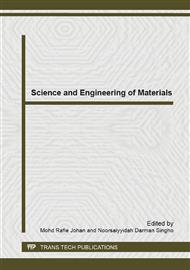[1]
C.K. Hsu, The preparation of biphasic porous calcium phosphate by the mixture of Ca(H2PO4)2. H2O and CaCO3, Mater. Chem. and Phys. 80 (2003) 409-420.
DOI: 10.1016/s0254-0584(02)00166-9
Google Scholar
[2]
A.N. Natasha, I. Sopyan, S. Ramesh, Afzeri, Phase behaviour of manganese-doped biphasic calcium phosphate ceramics synthesized via sol-gel method, Asia-Pacific J. Chem. Eng. 6 (2011) 823-831.
DOI: 10.1002/apj.480
Google Scholar
[3]
B. Liu, P. Lin, Y. Shen, Y. Dong, A novel sol–gel technique for hydroxyapatite preparation, J. Mater. Sci. Mater. Med. 19 (2008) 1203-1207.
Google Scholar
[4]
D. Tadic, F. Beckmann, K. Schwarz, M. Epple, A novel method to produce hydroxyapatite objects with interconnecting porosity that avoids sintering, Biomaterial., (25) 2004 3335-3340.
DOI: 10.1016/j.biomaterials.2003.10.007
Google Scholar
[5]
A. Harabi, D. Belamri, N. Karboua, F.Z. Mezahi, Sintering of bioceramics using a modified domestic microwave oven: Natural hydroxyapatite sintering, J. Therm. Anal. Calorimet. (104) 2011, 383-388.
DOI: 10.1007/s10973-010-1115-z
Google Scholar
[6]
M.O. Li, X. Xiao, R. Liu, C. Chen, L. Huang, Structural characterization and zinc-substituted hydroxyapatite prepared by hydrothermal method, J. Mater. Sci.: Mater. Med. (19) 2008, 797-803.
DOI: 10.1007/s10856-007-3213-4
Google Scholar
[7]
I. Sopyan, M. Mel, R. Singh, K.A. Khalid, Porous hydroxyapatite for artificial bone applications, Sci. Technol. Adv. Mater. 8 (2007) 116-123.
Google Scholar
[8]
A.C. Tas, F. Korkusuz, M. Timucin, N. Akkas, An investigation of the chemical synthesis and high temperature sintering behavior of calcium hydroxyapatite (HA) and tricalcium phosphate (TCP) bioceramics, J. Mater. Sci.: Mater. Med. 8 (1997) 91-96.
Google Scholar
[9]
N. Kivrak, A.C. Tas, Synthesis of calcium hydroxyapatite-tricalcium phosphate (HA-TCP) composite bioceramic powders and their sintering behaviour, J. Am. Ceram. Soc. 81 (1998) 2245-2252.
DOI: 10.1111/j.1151-2916.1998.tb02618.x
Google Scholar
[10]
N. Monmaturapoj, Nano-size hydroxyapatite powders preparation by wet chemical precipitation route, J. Met. Mater. Miner. 18 (2008) 15-20.
Google Scholar
[11]
A. Paz, D. Guadarrama, M. Lopez, J.E. Gonzalez, N. Brizuela, J. Aragon, A comparative study of hydroxyapatite nanoparticles synthesized by different routes, Quim Nova. 35 (2012) 1724-1727.
DOI: 10.1590/s0100-40422012000900004
Google Scholar
[12]
H.W. Kim, J.C. Knowles, H.E. Kim, Effect of biphasic calcium phosphate on drug release and biological and mechanical properties of poly (ε-caprolactone) composite membranes, J. Biomed. Mater. Res. A. 70A (2004) 467-479.
DOI: 10.1002/jbm.a.30100
Google Scholar
[13]
F. Wang, M. Li, Y. Lu, Y. Qi, A simple sol-gel technique for preparing hydroxyapatite nanopowders, Mater. Lett. (59) 2005 916-919.
Google Scholar
[14]
K.P. Sanosh, M.C. Chu, A. Balakrishnan, T.N. Kim, S.J. Cho, Pressureless sintering of nanocrytalline hydroxyapatite at different temperatures, Met. Mater. Int. 16(4) (2010) 605-611.
DOI: 10.1007/s12540-010-0813-1
Google Scholar
[15]
K. Seema, B. Uma, K. Suhcita, Transformations in sol-gel synthesized nanoscale hydroxyapatite calcined under different temperatures and time conditions', J. Mater. Eng and Perform., 2012, 21, 1737-1743.
DOI: 10.1007/s11665-011-0059-1
Google Scholar
[16]
Z. Xiu, M. Lu, S. Liu, G. Zhou, B. Su, H. Zhang, Barium hydroxyapatite nanoparticles synthesized by citric acid sol-gel combustion method, Mater. Res. Bull. 40 (2005) 1617-1622.
DOI: 10.1016/j.materresbull.2005.04.033
Google Scholar
[17]
S. Ramesh, Malaysia Patent PI 20043325. (2004).
Google Scholar
[18]
S.J. Kalita, S. Verma, Nanocrystalline hydroxyapatite bioceramic using microwave radiation: Synthesis and characterization, J. Mater. Sci. Eng. C. 30 (2010) 295-303.
DOI: 10.1016/j.msec.2009.11.007
Google Scholar
[19]
R. Morrissey, L.M. Rodriguez-Lorenzo, K.A. Gross, Influence of ferrous iron incorporation on the structure of hydroxyapatite, J. Mater. Sci. Mater. Med. 16 (2005) 387– 392.
DOI: 10.1007/s10856-005-6976-5
Google Scholar
[20]
A. Milev, G.S.K. Kannangara, B. Ben-Nissan, Morphological stability of hydroxyapatite precursor, Mater. Lett. 57 (2003) 1960-(1965).
DOI: 10.1016/s0167-577x(02)01112-6
Google Scholar
[21]
E. Landi, G. Logroscino, L. Proietti, A. Tampieri, M. Sandri, S. Sprio, Biomimetic Mg substituted hydroxyapatite: from synthesis to in vivo behavior, J. Mater. Sci. Mater. Med. 19 (2008) 239-247.
DOI: 10.1007/s10856-006-0032-y
Google Scholar
[22]
E.C. Victoria, F.D. Gnanam, Synthesis and characterization of biphasic calcium phosphate, Trends Biomater. Artif. Organs, 16 (2002) 12-14.
Google Scholar
[23]
A. Rapacz-Kmita, C. Paluszkiewicz, A. Slosarczyk, Z. Paszkiewicz, FTIR and XRD investigations on the thermal stability of hydroxyapatite during hot pressing and pressureless sintering processes, J. Mol. Struct. 744-747 (2005) 653–656.
DOI: 10.1016/j.molstruc.2004.11.070
Google Scholar
[24]
S. Lazic, S. Zec, N. Miljevic and S. Milonjic, The effect of temperature on the properties of hydroxyapatite precipitated from calcium hydroxide and phosphoric acid, Thermochim. Acta. 374 (2001) 13-22.
DOI: 10.1016/s0040-6031(01)00453-1
Google Scholar


